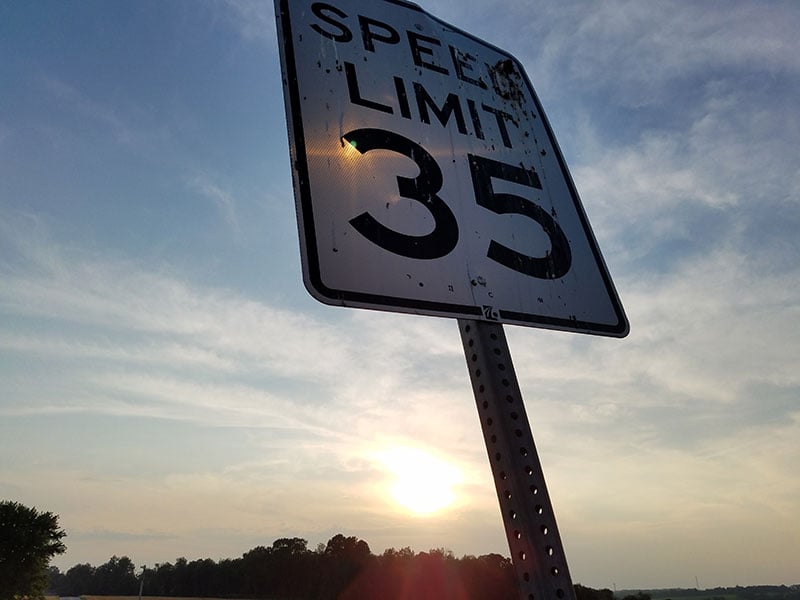Life is busy. We all have many places to be like baseball games, dance recitals, jobs, dinners, birthday gatherings, and more. But speeding to get there not only puts you at risk but also others who are driving on the roads with you.
According to the NHTSA (National Highway Traffic Safety Administration), there were 37,133 traffic fatalities in 2017. Among them, 9,717 (26%) were crashes where at least one driver was speeding. Specifically in Tennessee, there were 1,040 traffic fatalities in 2017, and 166 of them were speeding-related. That means 16% of the total traffic fatalities in Tennessee were speeding-related.
High Speed Accident Statistics
Higher speeds make crashes more likely because there is less time to slow down or to stop when needed. There is also more crash energy at higher speeds which translates to more damage to vehicles and more personal injuries. It’s very tempting to drive faster than the speed limit, and many states have actually raised speed limits. The maximum speed limit in 12 states has risen to 75 mph while six states have raised limits to 80 mph. In Texas, you can drive up to 85 mph on some roads. But research shows that when speed limits are raised, people still drive faster than the posted limit.
Here are some interesting statistics on speeding and crashes from 2017:
- The number of speeding-related fatalities in 2017 decreased by 6% from 2016, from 10,291 to 9,717.
- In 2017, 31% of male drivers and 18% female drivers in the 15-to-20 age group involved in fatal crashes were speeding, the highest among the age groups presented.
- In 2017, 37% of all speeding drivers in fatal crashes were alcohol-impaired, compared to 16% of non-speeding drivers involved in fatal crashes.
- In 2017, 32% of motorcycle riders involved in fatal crashes were speeding, more than drivers of any other vehicle type.
- In fatal crashes in 2017 nearly half (49%) of speeding passenger vehicle drivers were unrestrained at the time of crashes, compared to 21% of non-speeding passenger vehicle drivers.
- In 2017, when roadway function class was known, 87% of speeding-related fatalities occurred on non-interstate roadways.
We can learn from these statistics that speeding along with other factors like age, and alcohol consumption play a role in fatal crashes.
Have you been injured in a car accident?
Why is speeding dangerous?
Speed directly influences the risk of a crash and the severity of the injuries. It involves a lot of physics. We will spare you. But, we can discuss a few pointers that will illustrate just how damaging it can become. Speed influences a crash in three different ways:
- By the time a driver has to react the two cars are closer together
- The driver has to brake harder to stop
- The impact of the crash is more intense because the driver has to slam on the brake.
Doubling the speed means the braking distance becomes four times farther. A vehicle traveling at 55 mph would need six seconds to stop safely. During that time it will travel somewhere around 300 feet. That's longer than a football field. So, if a car increases the speed from 30 to 60 miles per hour that breaking distance would quadruple.
Safety mechanisms like seatbelts and airbags can't handle high-speed impacts. The faster the car is traveling the greater the risk you won't survive because these safety devices won't work properly.
What causes drivers to speed?
Realistically, speeding is an aggressive type of behavior and can be caused by different factors.
Running Late
Those who don't plan appropriately to get to their final destination will try to make up for the lost time by speeding. Circumstances like these might also lead to a driver participating in other reckless behavior like running a red light or cutting someone off.
Traffic
Congestion in traffic is mentioned frequently at the scene of an accident caused by speeding. A driver will get aggressive if they believe another driver is impeding on their ability to make to work or a meeting on time.
Lack of Observation
Sometimes when we drive frequently, we begin to desensitize to our surroundings. Instead of observing, individuals become detached. When feeling less connected to our surroundings, we start to make bad decisions like speeding.
Whatever the reason for speeding, whether it is a naive outlook on life, the need to “live dangerously,” or time constraints, think about how fast you are going and stay within the speed limits. It might be more that your own life that you are preserving. If you’ve been injured by a speeding driver, contract Bart Durham today.



